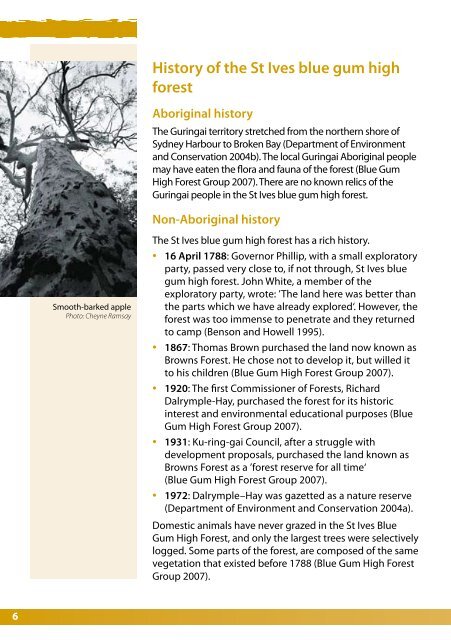Protecting and restoring Blue Gum High Forest - Department of ...
Protecting and restoring Blue Gum High Forest - Department of ...
Protecting and restoring Blue Gum High Forest - Department of ...
Create successful ePaper yourself
Turn your PDF publications into a flip-book with our unique Google optimized e-Paper software.
6<br />
Smooth-barked apple<br />
Photo: Cheyne Ramsay<br />
History <strong>of</strong> the St Ives blue gum high<br />
forest<br />
Aboriginal history<br />
The Guringai territory stretched from the northern shore <strong>of</strong><br />
Sydney Harbour to Broken Bay (<strong>Department</strong> <strong>of</strong> Environment<br />
<strong>and</strong> Conservation 2004b). The local Guringai Aboriginal people<br />
may have eaten the flora <strong>and</strong> fauna <strong>of</strong> the forest (<strong>Blue</strong> <strong>Gum</strong><br />
<strong>High</strong> <strong>Forest</strong> Group 2007). There are no known relics <strong>of</strong> the<br />
Guringai people in the St Ives blue gum high forest.<br />
Non-Aboriginal history<br />
The St Ives blue gum high forest has a rich history.<br />
• 16 April 1788:<br />
Governor Phillip, with a small exploratory<br />
party, passed very close to, if not through, St Ives blue<br />
gum high forest. John White, a member <strong>of</strong> the<br />
exploratory party, wrote: ’The l<strong>and</strong> here was better than<br />
the parts which we have already explored‘. However, the<br />
forest was too immense to penetrate <strong>and</strong> they returned<br />
to camp (Benson <strong>and</strong> Howell 1995).<br />
• 1867:<br />
Thomas Brown purchased the l<strong>and</strong> now known as<br />
Browns <strong>Forest</strong>. He chose not to develop it, but willed it<br />
to his children (<strong>Blue</strong> <strong>Gum</strong> <strong>High</strong> <strong>Forest</strong> Group 2007).<br />
• 1920:<br />
The first Commissioner <strong>of</strong> <strong>Forest</strong>s, Richard<br />
Dalrymple-Hay, purchased the forest for its historic<br />
interest <strong>and</strong> environmental educational purposes (<strong>Blue</strong><br />
<strong>Gum</strong> <strong>High</strong> <strong>Forest</strong> Group 2007).<br />
• 1931:<br />
Ku-ring-gai Council, after a struggle with<br />
development proposals, purchased the l<strong>and</strong> known as<br />
Browns <strong>Forest</strong> as a ’forest reserve for all time‘<br />
(<strong>Blue</strong> <strong>Gum</strong> <strong>High</strong> <strong>Forest</strong> Group 2007).<br />
• 1972:<br />
Dalrymple–Hay was gazetted as a nature reserve<br />
(<strong>Department</strong> <strong>of</strong> Environment <strong>and</strong> Conservation 2004a).<br />
Domestic animals have never grazed in the St Ives <strong>Blue</strong><br />
<strong>Gum</strong> <strong>High</strong> <strong>Forest</strong>, <strong>and</strong> only the largest trees were selectively<br />
logged. Some parts <strong>of</strong> the forest, are composed <strong>of</strong> the same<br />
vegetation that existed before 1788 (<strong>Blue</strong> <strong>Gum</strong> <strong>High</strong> <strong>Forest</strong><br />
Group 2007).

















